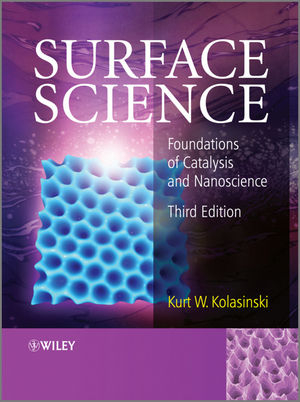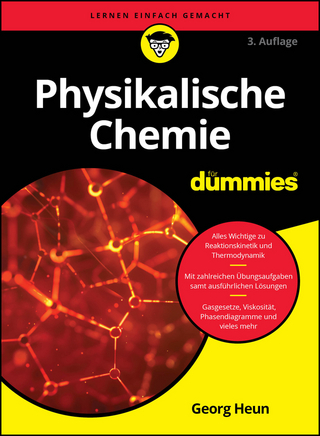
Surface Science
John Wiley & Sons Inc (Verlag)
978-1-119-99036-9 (ISBN)
- Titel erscheint in neuer Auflage
- Artikel merken
This text is suitable for all students taking courses in surface science in Departments of Chemistry, Physics, Chemical Engineering and Materials Science, as well as for researchers and professionals requiring an up-to-date review of the subject.
Professor Kurt Kolasinksi is based at West Chester University in the Department of Chemistry. His research concentrates on the study of dynamical processes at the surfaces of metals and semiconductors with a special emphasis on structure formation and laser-surface interactions. He is responsible for teaching Theoretical and Experimental Physical Chemistry as well as Surface Science. He has published extensively in key journals and is Editor of the Surface Science section of Current Opinion in Solid State and Materials Science. The second edition of his advanced text Surface Science was published in 2008.
Acknowledgements xv 1 Introduction 1 I.1 Heterogeneous catalysis 2 I.2 Why surfaces? 3 I.3 Where are heterogeneous reactions important? 3 I.4 Semiconductor processing and nanotechnology 4 I.5 Other areas of relevance 5 I.6 Structure of the book 5 1 Bulk and Surface Structure 9 1.1 Clean surface structure 10 1.2 Reconstruction and adsorbate structure 22 1.3 Band structure of solids 30 1.4 The vibrations of solids 41 1.5 Summary of important concepts 43 1.6 Frontiers and challenges 44 1.7 Further reading 44 1.8 Exercises 44 2 Experimental Probes and Techniques 51 2.1 Ultrahigh vacuum 51 2.2 Light and electron sources 53 2.3 Molecular beams 57 2.4 Scanning probe techniques 63 2.5 Low energy electron diffraction (LEED) 73 2.6 Electron spectroscopy 80 2.7 Vibrational spectroscopy 95 2.8 Second harmonic and sum frequency generation 103 2.9 Other surface analytical techniques 105 2.10 Summary of important concepts 106 2.11 Frontiers and challenges 106 2.12 Further reading 107 2.13 Exercises 107 3 Chemisorption, Physisorption and Dynamics 115 3.1 Types of interactions 115 3.2 Binding sites and diffusion 116 3.3 Physisorption 120 3.4 Non-dissociative chemisorption 121 3.5 Dissociative chemisorption: H2 on a simple metal 129 3.6 What determines the reactivity of metals? 130 3.7 Atoms and molecules incident on a surface 133 3.8 Microscopic reversibility in Ad/Desorption phenomena 144 3.9 The influence of individual degrees of freedom on adsorption and desorption 148 3.10 Translations, corrugation, surface atom motions 150 3.11 Rotations and adsorption 156 3.12 Vibrations and adsorption 158 3.13 Competitive adsorption and collision induced processes 158 3.14 Classification of reaction mechanisms 161 3.15 Measurement of sticking coefficients 165 3.16 Summary of important concepts 168 3.17 Frontiers and challenges 169 3.18 Further reading 170 3.19 Exercises 170 4 Thermodynamics and Kinetics of Adsorption and Desorption 185 4.1 Thermodynamics of Ad/Desorption 185 4.2 Adsorption isotherms from thermodynamics 190 4.3 Lateral interactions 193 4.4 Rate of desorption 194 4.5 Kinetics of adsorption 202 4.6 Adsorption isotherms from kinetics 210 4.7 Temperature programmed desorption (TPD) 213 4.8 Summary of important concepts 221 4.9 Frontiers and challenges 222 4.10 Further reading 222 4.11 Exercises 222 5 Liquid Interfaces 229 5.1 Structure of the liquid/solid interface 229 5.2 Surface energy and surface tension 234 5.3 Liquid films 239 5.4 Langmuir films 241 5.5 Langmuir-Blodgett films 243 5.6 Self assembled monolayers (SAMs) 248 5.7 Thermodynamics of liquid interfaces 254 5.8 Electrified and charged interfaces 257 5.9 Summary of important concepts 261 5.10 Frontiers and challenges 262 5.11 Further reading 262 5.12 Exercises 263 6 Heterogeneous Catalysis 267 6.1 The prominence of heterogeneous reactions 267 6.2 Measurement of surface kinetics and reaction mechanisms 269 6.3 Haber-Bosch process 273 6.4 From microscopic kinetics to catalysis 277 6.5 Fischer-Tropsch synthesis and related chemistry 283 6.6 The three-way automotive catalyst 286 6.7 Promoters 288 6.8 Poisons 290 6.9 Bimetallic and bifunctional catalysts 291 6.10 Rate oscillations and spatiotemporal pattern formation 292 6.11 Sabatier analysis and optimal catalyst selection 295 6.12 Summary of important concepts 296 6.13 Frontiers and challenges 297 6.14 Further reading 298 6.15 Exercises 298 7 Growth and Epitaxy 305 7.1 Stress and strain 305 7.2 Types of interfaces 308 7.3 Surface energy, surface tension and strain energy 310 7.4 Growth modes 311 7.5 Nucleation theory 317 7.6 Growth away from equilibrium 319 7.7 Techniques for growing layers 322 7.8 Catalytic growth of nanotubes and nanowires 327 7.9 Etching 332 7.10 Summary of important concepts 344 7.11 Frontiers and challenges 344 7.12 Further reading 345 7.13 Exercises 345 8 Laser and Non-Thermal Chemistry: Photon and Electron Stimulated Chemistry and Atom Manipulation 353 8.1 Photon excitation of surfaces 354 8.2 Mechanisms of electron and photon stimulated processes 366 8.3 Photon and electron induced chemistry at surfaces 374 8.4 Charge transfer and electrochemistry 384 8.5 Tip Induced process: mechanisms of atom manipulation 397 8.6 Summary of important concepts 404 8.7 Frontiers and challenges 404 8.8 Further reading 405 8.9 Exercises 405 References 408 9 Answers to Exercises from Chapter 1. Bulk and Surface Structure 415 10 Answers to Exercises from Chapter 2. Experimental Probes and Techniques 427 11 Answers to Exercises from Chapter 3. Chemisorption, Physisorption and Dynamics 445 12 Answers to Exercises from Chapter 4. Thermodynamics and Kinetics of Adsorption and Desorption 465 13 Answers to Exercises from Chapter 5. Liquid Interfaces 487 14 Answers to Exercises from Chapter 6. Heterogeneous Catalysis 499 15 Answers to Exercises From Chapter 7. Growth and Epitaxy 509 16 Answers to exercises from Chapter 8. Laser and Nonthermal Chemistry 515 Appendix I Abbreviations and Prefixes 531 Appendix II Symbols 535 Appendix III Useful Mathematical Expressions 541 Index 545
| Verlagsort | New York |
|---|---|
| Sprache | englisch |
| Maße | 194 x 255 mm |
| Gewicht | 1178 g |
| Themenwelt | Naturwissenschaften ► Chemie ► Physikalische Chemie |
| Technik ► Maschinenbau | |
| ISBN-10 | 1-119-99036-X / 111999036X |
| ISBN-13 | 978-1-119-99036-9 / 9781119990369 |
| Zustand | Neuware |
| Informationen gemäß Produktsicherheitsverordnung (GPSR) | |
| Haben Sie eine Frage zum Produkt? |
aus dem Bereich



